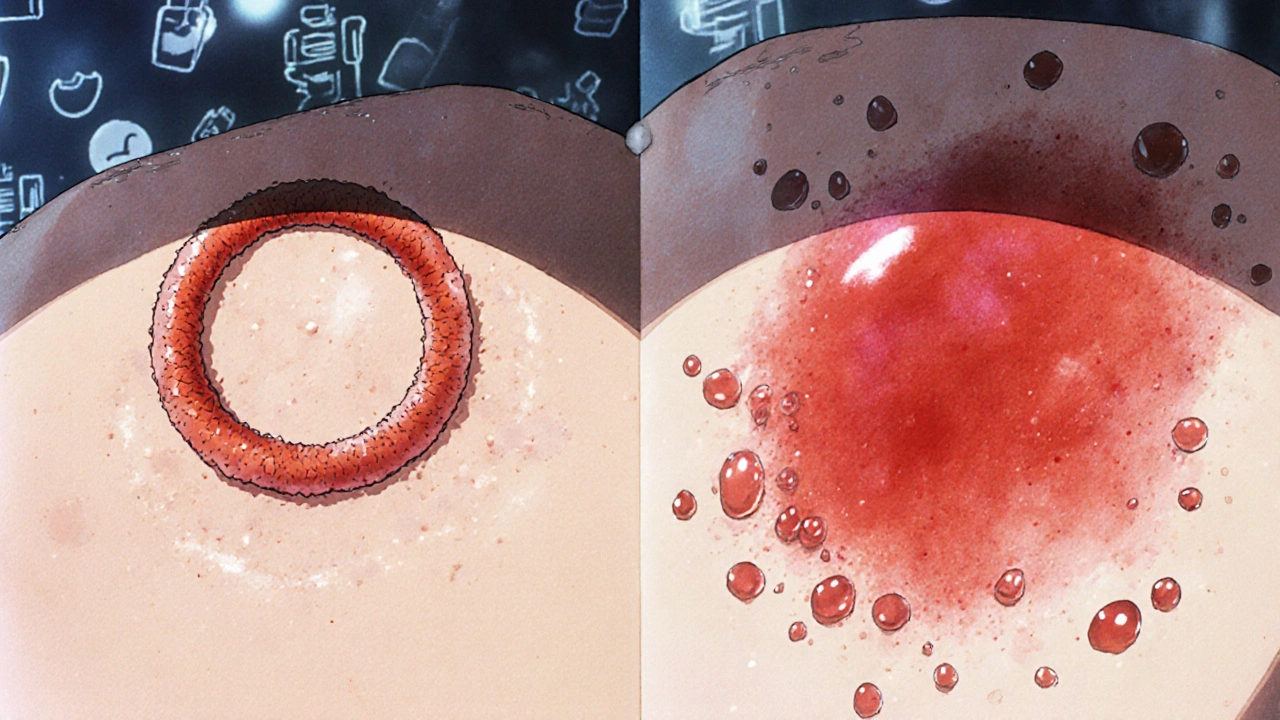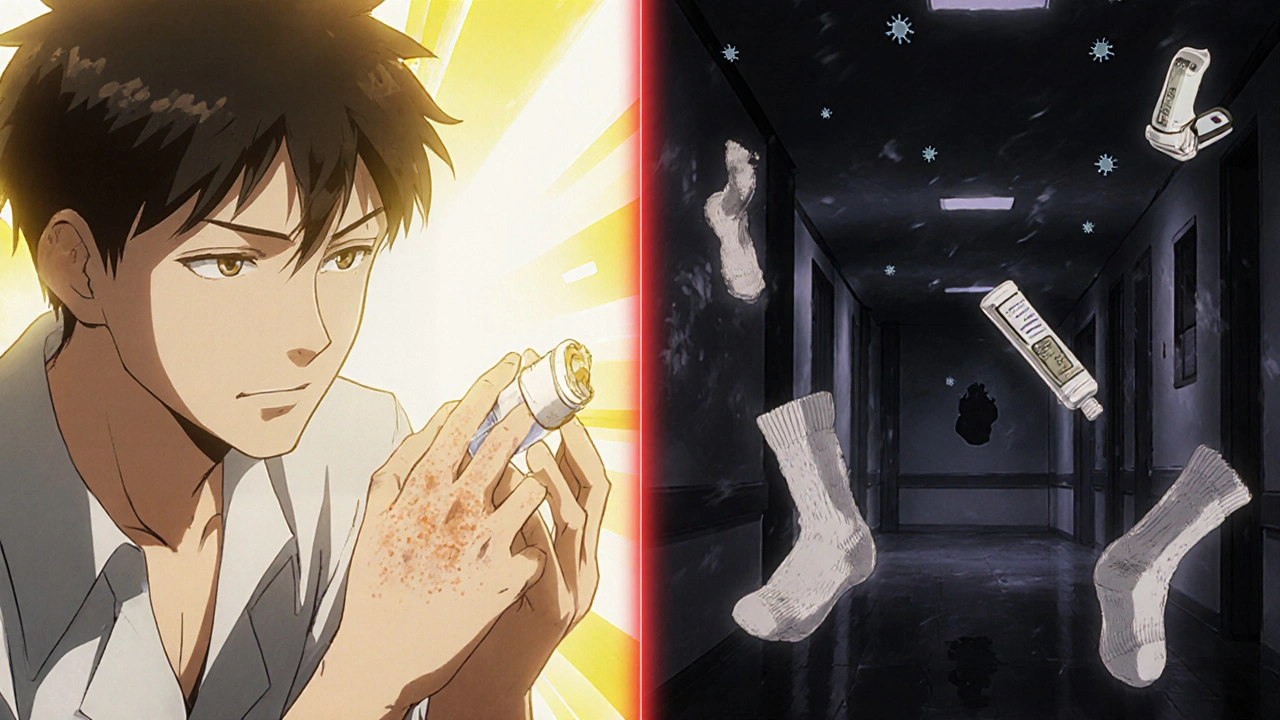Fungal Skin Infections: Candida, Ringworm, and Antifungals Explained

More than 1 in 5 people worldwide have a fungal skin infection right now. It’s not rare. It’s not unusual. And it’s not always what you think. You might blame a rash on eczema, sweat, or even an allergic reaction - but it could be a fungus. Two of the most common culprits? Candida and ringworm. Both cause red, itchy skin, but they’re totally different in how they behave, where they live, and how they’re treated.
What’s Actually Growing on Your Skin?
Ringworm isn’t a worm. It’s a fungus. The name comes from the old-school idea that the circular, red, scaly patch looked like a worm curled under the skin. Today, we know it’s caused by dermatophytes - fungi that feed on keratin, the protein in your skin, hair, and nails. The most common type, Trichophyton rubrum, makes up 80-90% of cases. It shows up as a raised, red ring with clearer skin in the middle. You’ll see it on your arms, legs, chest - anywhere the skin is warm and damp.
Candida, on the other hand, is yeast. It’s the same kind that causes thrush or vaginal yeast infections. Normally, it hangs out harmlessly in your gut or on your skin. But when conditions get warm and moist - like under your breasts, in your armpits, or in your diaper area - it multiplies fast. Candida doesn’t form rings. Instead, it creates a bright red, wet, sometimes pimply rash with tiny red dots (satellite pustules) around the edges. It’s common in babies with diaper rash, people with diabetes, or anyone who sweats a lot.
Who Gets These Infections - and Why?
Children under 10 are most likely to get ringworm on the scalp or body. Often, it comes from pets - especially cats and dogs with patchy fur. If your kid pets a stray or even your own cat with a bald spot, they could pick it up. In adults, ringworm on the feet (athlete’s foot) and groin (jock itch) is more common. Locker rooms, shared towels, and tight shoes create the perfect storm.
Candida infections are more tied to your body’s internal state. Diabetes? That raises your risk by 2.5 times. Antibiotics? They kill off good bacteria that normally keep yeast in check. Obesity? Skin folds trap moisture. Immune problems? You’re 3-5 times more likely to get a bad or recurring infection. And yes - wearing synthetic underwear or not drying off after a shower can tip the scales.
How Do You Know It’s Fungal - Not Something Else?
Doctors get it wrong nearly half the time. A 2022 study found primary care providers correctly identified ringworm in only 50-60% of cases. Many patients are told they have eczema or psoriasis - and end up using steroid creams that make the fungus spread. That’s why it’s so important to know what to look for.
Ringworm: circular, scaly, raised border, clears in the center. It often itches but doesn’t ooze. Candida: beefy red, moist, with little red bumps around the edges. It stings more than it itches. Both can be confirmed with a quick test: a scraping of the skin mixed with potassium hydroxide (KOH) under a microscope. The fungus shows up like little threads or spores. Culture tests take weeks, but KOH gives results in minutes.
If you’ve had the same rash for more than two weeks and OTC creams haven’t helped, get it checked. Don’t assume it’s just dry skin.

Topical Antifungals: What Actually Works
For most cases of ringworm on the body or Candida in skin folds, you don’t need pills. Over-the-counter creams work fine - if you use them right.
- Terbinafine (Lamisil): Best for ringworm. Kills fungus, doesn’t just slow it down. Apply twice a day for 1-2 weeks. Cure rate: 70-90%.
- Clotrimazole (Lotrimin): Good for both ringworm and Candida. Apply twice daily for 2-4 weeks. Works well for diaper rash and intertrigo.
- Nystatin: Used mostly for Candida in babies. Comes as cream or powder. Less effective than azoles but safe for long-term use.
Here’s the catch: most people stop using the cream as soon as the redness fades. That’s a mistake. Fungus hides deep in the skin. You need to keep applying for at least a week after the rash looks gone. A 2022 JAMA Dermatology study found only 45% of people finished their full course. That’s why 35% of users report the rash coming back.
When Do You Need Oral Medication?
Topical creams won’t touch nail infections (tinea unguium) or stubborn scalp ringworm. For those, you need pills.
- Terbinafine (oral): First choice for nail fungus. Take 250 mg daily for 6-12 weeks. Works in 80-90% of cases. Side effect? Liver enzymes can rise - your doctor will check them.
- Fluconazole: Used for Candida that won’t quit - especially if it’s in your mouth, throat, or genitals. Takes 1-2 weeks. But resistance is growing. In 2023, fluconazole prescriptions dropped 8% as doctors look for alternatives.
- Ibrexafungerp (Brexafemme): New FDA-approved pill for recurring vaginal yeast infections. Reduces recurrence by half over 48 weeks. Still pricey, but a game-changer for chronic sufferers.
Don’t take oral antifungals without a diagnosis. They’re not harmless. Liver damage, drug interactions, and side effects are real. Use them only when needed.
What About Probiotics and Natural Remedies?
On Reddit and Instagram, thousands of people swear by probiotics for recurring Candida. One June 2023 Instagram poll of 850 users found 65% had fewer flare-ups when they took Lactobacillus supplements alongside antifungals. It makes sense. Good bacteria crowd out yeast. But don’t rely on them alone. Probiotics help - they don’t cure.
Tea tree oil, coconut oil, and apple cider vinegar get lots of buzz. Some small studies show mild antifungal effects, but nothing compares to FDA-approved creams. If you use them, don’t skip your prescribed treatment. And never put undiluted essential oils on broken skin - it can burn.

The Hidden Threat: Drug-Resistant Fungi
There’s a quiet crisis brewing. Fungi are getting smarter. In North America, 5-7% of ringworm strains are now resistant to terbinafine. And then there’s Candida auris - a superbug first spotted in 2009. It’s now in 27 U.S. states. It clings to skin, spreads in hospitals, and resists multiple drugs. It’s not common in healthy people, but it’s deadly for those in ICUs or with weak immune systems.
Doctors are now using newer drugs like olorofim (still in trials) and ibrexafungerp to fight resistant strains. The WHO added five fungal pathogens to its priority list in 2022. That’s a wake-up call. Research funding jumped - $32 million from the NIH in 2023 alone. But for now, the best defense is still early diagnosis and finishing your treatment.
Prevention: Simple Steps That Make a Big Difference
You can’t always avoid fungi - they’re everywhere. But you can make your skin a bad place for them to live.
- Dry off completely after showers - especially between toes, under breasts, and in the groin.
- Wear cotton underwear and loose clothes. Skip synthetic fabrics.
- Don’t share towels, shoes, or combs.
- If your pet has bald patches, get them checked.
- Use antifungal powder in shoes if you’re prone to athlete’s foot.
- Control blood sugar if you have diabetes.
And if you’ve had one fungal infection? You’re more likely to get another. Stay vigilant. A quick check every few weeks can catch a recurrence before it spreads.
Final Thought: Don’t Ignore the Itch
Fungal skin infections aren’t glamorous. They’re messy, frustrating, and often misunderstood. But they’re treatable - if you know what you’re dealing with. Don’t let a rash linger because you think it’s just dry skin. Don’t keep using steroid cream hoping it’ll help. See a doctor. Get tested. Use the right medicine. Finish the course. And remember: you’re not alone. Millions of people deal with this every year. The trick isn’t magic. It’s consistency.
Can ringworm go away on its own?
Sometimes, yes - but it can take months, and you risk spreading it to others or to other parts of your body. Left untreated, ringworm can become chronic or lead to secondary bacterial infections. Antifungal treatment cuts recovery time from months to weeks and reduces the chance of recurrence.
Is Candida contagious?
Candida isn’t typically spread from person to person like a cold. But it can transfer through shared towels, clothing, or surfaces in damp areas like gyms or pools. It’s more about your body’s environment than direct transmission. If someone has a severe Candida infection and you have a weakened immune system, your risk increases.
Can I use the same cream for ringworm and Candida?
Many over-the-counter creams, like clotrimazole, work for both. But terbinafine is more effective for ringworm and less reliable for Candida. If you’re unsure, start with clotrimazole. If it doesn’t improve in 7-10 days, see a doctor. Using the wrong cream can delay healing.
Why does my fungal infection keep coming back?
Recurring infections usually mean one of three things: you didn’t finish your treatment, your environment hasn’t changed (e.g., you still wear sweaty shoes), or you have an underlying condition like diabetes or a weakened immune system. People with diabetes or who take steroids regularly are at higher risk. A doctor can help identify the root cause.
Are antifungal creams safe for babies?
Yes, but only certain ones. Nystatin and mild clotrimazole creams are safe for diaper rash caused by Candida. Avoid strong antifungals like terbinafine on infants unless directed by a pediatrician. Always clean and dry the area thoroughly before applying cream. If the rash doesn’t improve in 3 days, see a doctor.
Do I need to throw away my shoes if I have athlete’s foot?
No, but you should disinfect them. Sprinkle antifungal powder inside, or spray with a solution of 1 part vinegar to 2 parts water. Let them air out in sunlight for a few hours. Replace old, worn-out shoes if they’re always damp. Fungus can survive in shoes for months - so treating the environment is just as important as treating your skin.